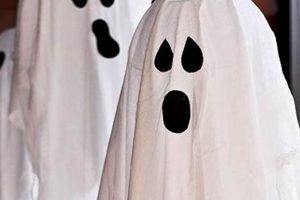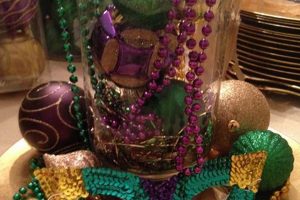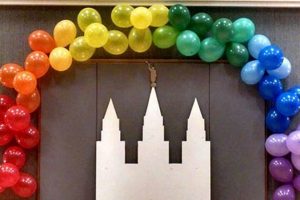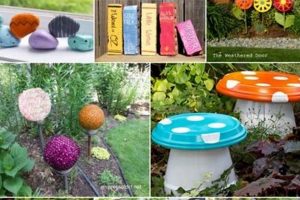Creating festive adornments for the Halloween season through the application of paper-based materials and do-it-yourself methods encompasses a popular crafting activity. This involves the use of paper, scissors, glue, and imagination to produce items such as paper bats, garlands, lanterns, and window clings for decorative purposes.
The practice of constructing Halloween decorations by hand provides several advantages. It represents a cost-effective alternative to purchasing commercially manufactured items, allowing for budget-friendly seasonal embellishments. Furthermore, it fosters creativity, enabling individuals to personalize their decorations to match specific themes or preferences. Historically, handmade decorations were a common aspect of Halloween celebrations, reflecting a tradition of resourcefulness and artistic expression.
This article will delve into various techniques for crafting paper-based Halloween decorations. It will explore specific project ideas, offer guidance on material selection, and provide step-by-step instructions for realizing a range of festive designs.
Crafting Successful Paper Halloween Adornments
Effective creation of seasonal embellishments using paper requires careful consideration of technique and material selection. The following guidelines provide insight into optimizing the crafting process.
Tip 1: Material Selection: Opt for paper weights appropriate for the intended design. Cardstock offers durability for freestanding figures, while thinner paper facilitates intricate cuts for garlands or layered projects.
Tip 2: Precision Cutting: Utilize sharp scissors or craft knives to achieve clean lines and accurate shapes. A self-healing cutting mat is recommended when employing craft knives to protect work surfaces.
Tip 3: Template Utilization: Employ templates for consistent shape replication. Templates can be sourced online, created by hand, or adapted from existing designs.
Tip 4: Adhesive Application: Select adhesives based on material compatibility and project requirements. Glue sticks are suitable for general assembly, while hot glue guns offer stronger bonds for three-dimensional structures. Exercise caution when using hot glue to avoid burns.
Tip 5: Reinforcement Strategies: Reinforce delicate paper structures with additional layers of paper or cardboard to enhance stability and prevent damage.
Tip 6: Safe Storage: Store finished decorations in a dry, protected environment to prevent moisture damage or tearing. Use acid-free tissue paper when layering decorations to prevent color transfer.
Tip 7: Design Considerations: Plan decorations in advance, considering color palettes, themes, and overall aesthetic cohesion. Coordinate paper colors and patterns to create a unified visual impact.
The adherence to these principles contributes to the creation of durable, visually appealing, and safe seasonal decorations. Diligent execution ensures lasting results.
The subsequent sections of this article will present specific project examples, incorporating these techniques for comprehensive guidance.
1. Cost-effectiveness
The economic advantage of crafting seasonal decorations from paper significantly contributes to the popularity of do-it-yourself Halloween projects. The accessibility of inexpensive materials allows for extensive decoration without incurring substantial expenditure.
- Reduced Material Costs
Paper, glue, scissors, and ink represent readily available and comparatively inexpensive materials. In contrast to commercially produced decorations, which often involve significant manufacturing and distribution costs, these materials offer a budget-friendly alternative. Utilizing recycled paper further reduces material expenses and promotes sustainable practices.
- Elimination of Labor Costs
The do-it-yourself nature of paper Halloween decorations eliminates the labor costs associated with mass production. Individuals contribute their own time and effort, resulting in a product that reflects personal investment rather than commercial overhead. This element significantly lowers the overall cost per decoration.
- Extended Lifespan through Repair and Repurposing
While paper decorations may not possess the same durability as some commercial alternatives, simple repairs can extend their lifespan. Tears can be mended with tape or glue, and faded colors can be refreshed with paint or markers. Furthermore, damaged or outdated decorations can be repurposed into new projects, minimizing waste and maximizing the initial investment.
- Avoidance of Storage Fees
Paper decorations often fold flat or occupy minimal space when stored, reducing the need for extensive storage solutions. This contrasts with bulky commercial decorations that may necessitate dedicated storage containers or even off-site storage facilities, incurring additional expenses.
The collective impact of reduced material costs, eliminated labor expenses, extended lifespan through repair, and avoidance of storage fees positions paper Halloween decorations as a fiscally responsible option for individuals seeking to create a festive atmosphere without exceeding budgetary constraints. The inherent affordability further democratizes the holiday experience, enabling broader participation in celebratory traditions.
2. Creative Expression
Creative expression serves as a foundational element of crafting paper Halloween decorations. The inherently flexible nature of paper as a medium allows for a wide range of artistic interpretations, moving beyond the limitations of pre-fabricated decorations. Individual vision directly dictates the aesthetic outcome, fostering a tangible connection between the creator and the finished product.
The capacity for creative expression influences several aspects of the decoration process. For example, a desire to replicate a specific monster design not commonly available commercially necessitates the design and construction of a unique paper figure. Similarly, a limited color palette may encourage innovative paper layering or shading techniques to achieve desired visual effects. Paper crafts, such as Kirigami, and Origami are a great way to allow creative expression. It is about self-expression and uniqueness.
The freedom to express creativity in paper Halloween decorations benefits both the individual and the final product. The craftsman experiences an active role, not just the creation. The decoration itself becomes a unique reflection of personality, injecting a personal touch. This blend of artistry enriches the Halloween aesthetic and strengthens the bond between the craftsman and their creative endeavor. The activity’s appeal is directly tied to its capacity for creative self-expression.
3. Material Versatility
Material versatility represents a cornerstone of crafting Halloween decorations from paper. The inherent adaptability of paper-based materials allows for a spectrum of design choices and construction techniques, catering to diverse skill levels and aesthetic preferences.
- Variety of Paper Types
The term “paper” encompasses a broad range of materials, each possessing distinct properties suitable for specific applications. Cardstock provides structural rigidity for freestanding figures, while crepe paper offers pliability for creating streamers and textured elements. Tissue paper lends itself to delicate overlays and translucent effects, whereas corrugated cardboard can be repurposed for robust, three-dimensional structures. The selection of paper type directly influences the durability, visual texture, and structural integrity of the finished decoration.
- Adaptability to Diverse Techniques
Paper’s inherent malleability allows for the application of numerous crafting techniques, including cutting, folding, scoring, gluing, and painting. Intricate designs can be achieved through precise cutting with scissors or craft knives, while origami techniques enable the creation of complex three-dimensional shapes. Scoring facilitates clean folds for creating geometric forms, and adhesive application secures structural components. Painting, drawing, and printing techniques further augment the decorative possibilities, allowing for customized patterns, textures, and color schemes.
- Combinability with Other Materials
Paper-based elements can be readily integrated with other materials to enhance the aesthetic appeal and structural integrity of Halloween decorations. Wooden dowels or skewers can provide support for freestanding figures, while string or yarn can be used for creating garlands and hanging ornaments. Adhesive embellishments, such as glitter, sequins, and googly eyes, add visual interest and textural contrast. The strategic combination of paper with complementary materials broadens the design possibilities and reinforces structural weaknesses.
- Reclamation and Upcycling Potential
The utilization of recycled paper and cardboard aligns with sustainable practices and promotes resource conservation. Discarded newspapers, magazines, and packaging materials can be repurposed into decorative elements, reducing waste and minimizing environmental impact. This approach fosters creativity by encouraging the adaptation of existing materials to new purposes and provides a cost-effective alternative to purchasing new paper products.
The composite effect of diverse paper types, adaptable techniques, combinability with other materials, and reclamation potential underscores the material versatility inherent in crafting paper Halloween decorations. This inherent flexibility allows for almost limitless aesthetic customization and responsible resource utilization, contributing significantly to the enduring appeal of the activity.
4. Skill Development
The creation of Halloween decorations using paper and do-it-yourself methods necessitates the acquisition and refinement of various skills. This crafting activity serves as a practical platform for developing dexterity, problem-solving abilities, and artistic sensibilities.
- Fine Motor Skills
Manipulating paper to create intricate designs directly enhances fine motor skills. Cutting, folding, and gluing paper elements require precise hand-eye coordination and control. Individuals involved in this crafting activity progressively improve their dexterity and accuracy, skills applicable to a wide range of tasks beyond decoration creation. Examples include cutting complex shapes for paper bats or precisely folding origami ghosts. These skills translate to everyday activities such as writing, typing, and detailed assembly tasks.
- Spatial Reasoning
Constructing three-dimensional decorations from two-dimensional paper requires spatial reasoning. Visualizing how flat paper will transform into a volumetric object necessitates mental manipulation and spatial awareness. Successfully assembling paper lanterns or building paper-mache pumpkins demonstrates an understanding of spatial relationships and transformations. This skill extends to fields like architecture, engineering, and even packing objects efficiently.
- Problem-Solving
Encountering challenges during the crafting process fosters problem-solving abilities. Tearing paper, misaligned cuts, or structural instability necessitate creative solutions. Individuals learn to adapt their designs, reinforce weak points, or troubleshoot technical issues. For example, if a paper spiderweb collapses, the craftsman might experiment with different paper thicknesses or support structures. This problem-solving experience is transferable to various domains, encouraging resourcefulness and adaptability in overcoming obstacles.
- Design and Aesthetic Awareness
Selecting colors, patterns, and shapes for paper decorations cultivates design and aesthetic awareness. Individuals learn to balance visual elements, create cohesive themes, and express their artistic preferences. Choosing complementary colors for a paper garland or designing a unique paper mask hones aesthetic sensibilities. This skill has applications in interior design, fashion, and visual communication, enabling individuals to make informed and creative choices in various aesthetic contexts.
The development of fine motor skills, spatial reasoning, problem-solving capabilities, and design awareness through the construction of paper Halloween decorations underscores the activity’s educational value. Beyond mere aesthetic creation, this crafting process cultivates a diverse range of skills applicable across numerous domains, enhancing both creative expression and practical competence.
5. Personalization Options
The appeal of crafting Halloween decorations from paper stems significantly from the vast array of personalization options afforded by the medium. This capacity for individualized expression transforms generic decorations into unique reflections of personal taste and thematic preferences. The causal relationship is direct: the inherent malleability of paper enables extensive modification, leading to highly customized decorative outcomes. The importance of personalization within the context of paper-based Halloween adornments cannot be overstated; it represents a core driver of the activity’s popularity and its distinction from mass-produced alternatives.
Personalization manifests across several dimensions. Color palettes can be tailored to match specific home dcor or desired moods. Intricate paper cutting techniques allow for the creation of bespoke silhouettes and patterns, reflecting individual artistic skill and thematic preferences. For example, a household celebrating a Dia de los Muertos-themed Halloween might craft sugar skull decorations from brightly colored paper, while a family favoring a classic horror aesthetic might opt for black and white paper bats and haunted house silhouettes. Further, digital templates and printing capabilities permit the incorporation of personalized imagery and text, transforming paper decorations into bespoke keepsakes. A simple paper banner, for instance, can be transformed by printing family names or inside jokes onto the paper before assembly. Understanding these personalization options yields practical benefits. It enables individuals to create truly unique and memorable Halloween displays, fostering a stronger sense of ownership and connection to the decorations. It allows a unique theme that is not traditionally available to decorate it.
In summary, the profound degree of personalization available when crafting Halloween decorations from paper establishes a significant value proposition. This inherent adaptability allows for the seamless integration of individual creativity and thematic preferences, transforming commonplace materials into unique and expressive artifacts. The challenges associated with personalization lie primarily in the development of necessary crafting skills and the investment of time. Despite these obstacles, the allure of creating truly personalized Halloween decorations continues to drive the popularity of paper-based do-it-yourself projects. In a world of mass-produced commodities, the act of crafting personalized decorations offers a tangible expression of individuality and creativity.
6. Environmental Consciousness
Environmental consciousness constitutes a significant element in the realm of creating Halloween decorations utilizing paper-based materials and do-it-yourself techniques. The selection of materials and the crafting process itself directly affect the environmental impact. A heightened awareness of ecological concerns prompts a shift toward sustainable practices in decoration creation, mitigating potential harm to the environment. The use of recycled paper, for instance, directly reduces the demand for virgin wood pulp, thereby conserving forests and minimizing deforestation. Similarly, employing water-based, non-toxic adhesives and paints minimizes the release of volatile organic compounds (VOCs) into the atmosphere, contributing to improved air quality. A practical example is the creation of paper garlands from discarded newspapers or magazines, transforming waste materials into decorative elements. This conscious selection and repurposing demonstrate a commitment to reducing environmental footprint. Choosing biodegradable materials also ensures that decorations, at the end of their lifespan, decompose naturally without leaving persistent pollutants.
Further extending environmental consciousness within this domain involves responsible disposal practices. Instead of discarding paper decorations into landfills, composting them when feasible offers an environmentally sound alternative. Composting accelerates the decomposition process, enriching soil and reducing the accumulation of waste. Furthermore, promoting the reuse and repurposing of decorations from year to year minimizes the need for new materials, thereby decreasing resource consumption. For example, paper lanterns can be carefully stored and reused annually, or modified with new embellishments to create a fresh look. Emphasizing these reuse and responsible disposal methods amplifies the positive environmental impact of crafting decorations from paper. Supporting businesses that sell recycled crafting supplies further reinforces a commitment to sustainability within this practice.
In summary, integrating environmental consciousness into the creation of paper Halloween decorations yields tangible benefits, including reduced resource consumption, minimized waste generation, and decreased pollution. This mindful approach not only enhances the aesthetic appeal of decorations but also promotes responsible environmental stewardship. Challenges remain in raising awareness and encouraging widespread adoption of sustainable practices. However, the collective effort to prioritize environmental consciousness within this context contributes to a more sustainable and ecologically balanced approach to celebrating Halloween.
7. Family Engagement
Family engagement functions as a catalyst within the context of paper Halloween decorations. The activity inherently encourages collaborative participation, transforming the creation process into a shared experience. The cause-and-effect relationship is demonstrable: providing accessible materials and straightforward instructions prompts family members to contribute their skills and ideas. The importance of family engagement lies in its capacity to strengthen interpersonal bonds, foster creativity in a supportive environment, and create lasting memories. For example, a family might collaboratively design and construct a haunted house facade from cardboard and paper, with each member contributing specific elements such as windows, doors, or miniature paper ghosts. This shared effort fosters a sense of collective accomplishment and strengthens familial connections.
Further analysis reveals that family engagement in this activity extends beyond mere task completion. It offers opportunities for intergenerational learning and skill transfer. Older family members can impart crafting techniques and design principles to younger members, preserving traditional skills and fostering a sense of continuity. Conversely, younger members may introduce innovative design ideas and technological approaches, such as using digital templates or incorporating LED lighting into paper creations. This exchange of knowledge enriches the crafting process and promotes mutual respect and appreciation. A practical application of this understanding involves organizing structured crafting sessions with clear objectives and roles for each participant, maximizing engagement and minimizing potential conflicts. It also enables family members to learn and grow together.
In conclusion, family engagement significantly enhances the value of creating Halloween decorations from paper. This collaborative endeavor strengthens familial bonds, fosters creativity, and facilitates intergenerational learning. While challenges may arise in managing diverse skill levels and preferences, the benefits of shared creative experiences outweigh potential drawbacks. By recognizing and nurturing family engagement, paper-based Halloween decoration projects become more than mere decorative activities; they transform into opportunities for building stronger, more connected families. It can also serve as a wonderful tool for communication and creating unforgettable memories.
Frequently Asked Questions
This section addresses common inquiries regarding the creation and implementation of Halloween decorations through paper crafting and do-it-yourself methodologies.
Question 1: What types of paper are most suitable for durable Halloween decorations?
Cardstock is generally preferred for its rigidity and ability to maintain its shape, particularly for freestanding figures. For intricate details and delicate designs, thinner paper such as crepe or tissue paper may be employed; however, these require reinforcement for longevity.
Question 2: How can paper decorations be protected from moisture damage?
Applying a sealant or laminate to the finished decorations provides a protective barrier against moisture. Ensure the sealant is compatible with the paper type to prevent discoloration or damage. Storing decorations in airtight containers when not in use is also advisable.
Question 3: What are the most effective adhesives for assembling paper Halloween decorations?
Glue sticks offer a clean and convenient option for general assembly. Hot glue guns provide a stronger bond for three-dimensional structures, although caution must be exercised to avoid burns. Double-sided tape is suitable for adhering paper to surfaces without visible adhesive residue.
Question 4: How can templates be utilized to ensure consistent and accurate paper cutting?
Templates can be printed from online sources or created by hand. Adhering the template to the paper with temporary adhesive spray ensures stability during cutting. Craft knives and self-healing cutting mats are recommended for precision cutting along template lines.
Question 5: What safety precautions should be observed when using craft knives or hot glue guns?
Always use a self-healing cutting mat to protect work surfaces when employing craft knives. Keep fingers clear of the blade’s path. Exercise extreme caution when using hot glue guns to avoid burns. Allow the glue to cool completely before handling assembled pieces.
Question 6: How can paper Halloween decorations be stored to prevent damage and ensure reusability?
Store decorations in a dry, cool environment, away from direct sunlight. Use acid-free tissue paper to separate layers and prevent color transfer. Place delicate items in rigid containers to protect them from crushing or bending.
These answers address essential considerations for those engaging in the creation of Halloween decorations from paper. Diligent attention to these principles contributes to durable, aesthetically pleasing, and safe outcomes.
The subsequent section of this article will delve into advanced techniques for creating paper Halloween decorations.
Conclusion
The preceding analysis demonstrates that paper halloween decorations diy represent a multifaceted activity extending beyond mere seasonal adornment. It encompasses cost-effective creativity, skill development, personalization, environmental consciousness, and family engagement. Successful execution demands attention to material selection, construction techniques, and safety precautions.
Mastery of paper halloween decorations diy contributes to enhanced crafting proficiency and festive displays. The future of this practice likely involves increased integration of digital design tools and sustainable materials. Continued exploration and refinement will solidify its position as a valuable and accessible creative outlet.







